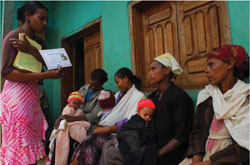Passive surveillance
Passive surveillance refers to the collection of data by health facilities as part of their routine work of diagnosis and treatment (figure below). It is called 'passive' because the data is obtained only from the people who seek help from the health services – the health professionals make no additional effort to contact other individuals. Passive surveillance system is based on monthly activity reports and weekly reporting of notifiable diseases, i.e. diseases that must be reported to the health authorities. Most communicable disease outbreaks should be reported immediately.

Passive surveillance is cheap to operate, because it takes place as part of routine health-service work, and it helps you and the higher authorities to monitor the occurrence of many diseases and other health problems. However, it has some disadvantages. The surveillance reports may take a long time to reach the highest level, and some key information may be lacking (e.g. if the health professional forgets to collect data on a statistic such as the sex or age of some patients).
What gaps could there be in the data on diseases/disorders in a community if the data are only collected through passive surveillance?
Passive surveillance misses all the cases out in the community in people who haven't sought help from the health services. This gap is a particular concern in remote areas, where people may not be able to access health services easily.